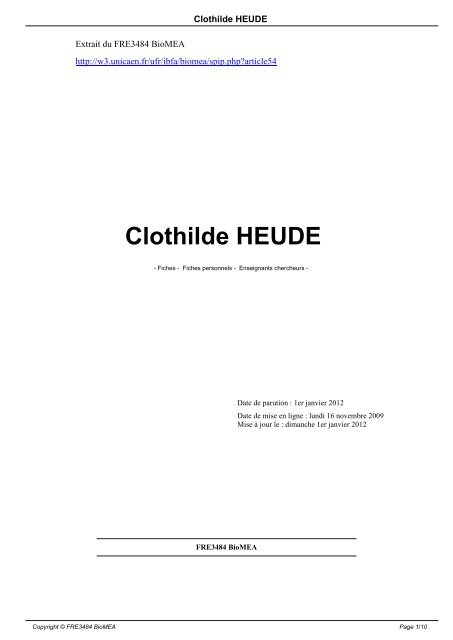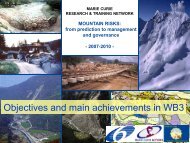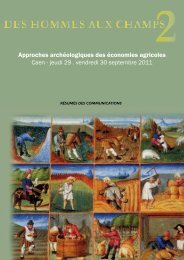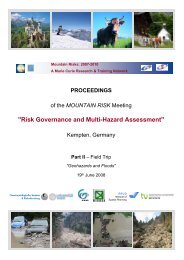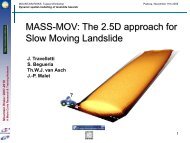Clothilde HEUDE - Université de Caen Basse Normandie
Clothilde HEUDE - Université de Caen Basse Normandie
Clothilde HEUDE - Université de Caen Basse Normandie
Create successful ePaper yourself
Turn your PDF publications into a flip-book with our unique Google optimized e-Paper software.
Extrait du FRE3484 BioMEA<br />
<strong>Clothil<strong>de</strong></strong> <strong>HEUDE</strong><br />
http://w3.unicaen.fr/ufr/ibfa/biomea/spip.php?article54<br />
<strong>Clothil<strong>de</strong></strong> <strong>HEUDE</strong><br />
- Fiches - Fiches personnels - Enseignants chercheurs -<br />
FRE3484 BioMEA<br />
Date <strong>de</strong> parution : 1er janvier 2012<br />
Date <strong>de</strong> mise en ligne : lundi 16 novembre 2009<br />
Mise à jour le : dimanche 1er janvier 2012<br />
Copyright © FRE3484 BioMEA Page 1/10
Sommaire<br />
• Responsabilités administratives<br />
• Responsabilités pédagogiques<br />
• Responsabilités scientifiques<br />
• Participation à <strong>de</strong>s programmes<br />
• Thèmes <strong>de</strong> recherche<br />
• Liste complète <strong>de</strong>s publications<br />
<strong>Clothil<strong>de</strong></strong> <strong>HEUDE</strong><br />
Enseignant chercheur, Maître <strong>de</strong> Conférences <strong>Université</strong> <strong>de</strong> <strong>Caen</strong> <strong>Basse</strong>-<strong>Normandie</strong> Section <strong>de</strong> Recherche : CNU<br />
68 Equipe <strong>de</strong> rattachement : Physiologie <strong>de</strong> la reproduction <strong>de</strong>s Mollusques Marins (PhyMR).<br />
E mail : clothil<strong>de</strong>.heu<strong>de</strong>@unicaen.fr Tel : 02 31 56 51 14 Adresse postale CNRS INEE - FRE3484 BioMEA Biologie<br />
<strong>de</strong>s Mollusques Marins et <strong>de</strong>s Ecosystèmes Associés Esplana<strong>de</strong> <strong>de</strong> la Paix IBFA - UNIVERSITE DE CAEN<br />
BASSE-NORMANDIE 14032 CAEN CEDEX<br />
Responsabilités administratives :<br />
" Membre du vivier interne <strong>de</strong> constitution du Comité <strong>de</strong> Sélection <strong>de</strong> 68ème section (UCBN) " Membre extérieur du<br />
comité <strong>de</strong> sélection (68ème section), <strong>Université</strong> du Havre.<br />
Responsabilités pédagogiques<br />
" Responsable pédagogique <strong>de</strong> la première année d'étu<strong>de</strong> <strong>de</strong> l'ESIX AgroA " Prési<strong>de</strong>nte du jury d'examen <strong>de</strong> première<br />
année ESIX AgroA " Membre du Conseil <strong>de</strong> Perfectionnement <strong>de</strong> l'ESIX AgroA " Membre <strong>de</strong>s jurys d'examen <strong>de</strong><br />
<strong>de</strong>uxième année ESIX AgroA et licence professionnelle « Innovation et Assemblages Culinaires »<br />
Responsabilités scientifiques :<br />
" Programme <strong>de</strong> Recherche Vème Plan Régional : Appui scientifique aux filières professionnelles <strong>de</strong> la pêche et <strong>de</strong>s<br />
cultures marines. Coordinatrice <strong>de</strong> l'Action 3 : Bases d'étu<strong>de</strong> <strong>de</strong> la reproduction <strong>de</strong>s mollusques marins en vue d'une<br />
exploitation durable par les professionnels <strong>de</strong> la côte ouest du Cotentin.<br />
Participation à <strong>de</strong>s programmes<br />
" Projet européen REPROSEED (2009-2012). Research to improve Production of seed of established and emerging<br />
bivalve species in European hatcheries " Programme <strong>de</strong> Recherche Vème Plan Regional (2008-2013). Appui<br />
scientifique aux filières professionnelles <strong>de</strong> la pêche et <strong>de</strong>s cultures marines. Action 4 : Comparaison d'huîtres<br />
diploï<strong>de</strong>s et triploï<strong>de</strong>s : développement <strong>de</strong> marqueurs liés à la reproduction et à la mise en réserve énergétique pour<br />
Copyright © FRE3484 BioMEA Page 2/10
l'exploitation <strong>de</strong> Crassostrea gigas.<br />
Thèmes <strong>de</strong> recherche<br />
<strong>Clothil<strong>de</strong></strong> <strong>HEUDE</strong><br />
" Mots clés : Mollusques - Gamétogenèse - Spermatogenèse - Proliférations cellulaires - Cellules somatiques<br />
intragonadiques<br />
La thématique développée tend à explorer la physiologie <strong>de</strong> la reproduction <strong>de</strong>s mollusques bivalves avec comme<br />
espèce modèle l'huître creuse Crassostrea gigas. La régulation <strong>de</strong>s proliférations cellulaires au cours <strong>de</strong> la<br />
gamétogenèse est un axe important <strong>de</strong> recherche abordé par <strong>de</strong>s approches cellulaires, immunologiques et<br />
moléculaires. Les premiers tris <strong>de</strong> cellules germinales d'huître (spermati<strong>de</strong>s et spermatogonies/spermatocytes) sont<br />
en cours <strong>de</strong> développement.<br />
Liste complète <strong>de</strong>s publications<br />
2013<br />
Jouaux, A., Blin, J. L., A<strong>de</strong>line, B., Heu<strong>de</strong>-Berthelin, C., Sourdaine, P., Mathieu, M., et al. (2013).<br />
Impact of energy storage strategies on gametogenesis and reproductive effort in diploid and triploid<br />
Pacific oysters Crassostrea gigas . Involvement of Insulin signaling. Aquaculture, .<br />
[toggle visibility]<br />
Permanent link<br />
| Stocker citation: RTF PDF LaTeX<br />
| Exporter enregistrement: BibTeX Endnote ISI RIS Atom XML MODS XML ODF XML Word XML<br />
2012<br />
Jouaux A, Franco A., Heu<strong>de</strong>-Berthelin C, Sourdaine P, Blin J.L, Mathieu M, et al. (2012).<br />
I<strong>de</strong>ntification of Ras, Pten and P70S6K homologs in the Pacific oyster Crassostrea gigas and diet<br />
control of insulin pathway. General and Comparative Endocrinology., 176(1), 28-38.<br />
[toggle visibility]<br />
Permanent link<br />
| Stocker citation: RTF PDF LaTeX<br />
| Exporter enregistrement: BibTeX Endnote ISI RIS Atom XML MODS XML ODF XML Word XML<br />
[Détails]<br />
[openurl]<br />
[Détails][doi]<br />
Copyright © FRE3484 BioMEA Page 3/10
2011<br />
<strong>Clothil<strong>de</strong></strong> <strong>HEUDE</strong><br />
Franco, A., Kellner K., Goux D., Mathieu M., & Heu<strong>de</strong> Berthelin C. (2011). Intragonadal Somatic<br />
Cells (ISCs) in the male oyster Crassostrea gigas: Morphology and contribution in germinal<br />
epithelium structure. Micron, 42(7), 718-725.<br />
[toggle visibility]<br />
Permanent link<br />
| Stocker citation: RTF PDF LaTeX<br />
| Exporter enregistrement: BibTeX Endnote ISI RIS Atom XML MODS XML ODF XML Word XML<br />
Franco, A., Kellner, K., Mathieu, M., Lelong, C., Goux, D., & Heu<strong>de</strong>-Berthelin, C. (2011). Male<br />
germ cells of the Pacific oyster Crassostrea gigas: flow cytometric analysis, cell sorting and<br />
molecular expression. Aquatic Living Ressources, 24, 237-245.<br />
[toggle visibility]<br />
Permanent link<br />
| Stocker citation: RTF PDF LaTeX<br />
| Exporter enregistrement: BibTeX Endnote ISI RIS Atom XML MODS XML ODF XML Word XML<br />
Heu<strong>de</strong>-Berthelin, C., Hégron-Macé, L., Legrand, V., Jouaux, A., A<strong>de</strong>line, B., Mathieu, M., et al.<br />
(2011). Growth and reproduction of the common whelk Buccinum undatum in west Cotentin<br />
(Channel), France. Aquat. Living Resour, 24, 317-327.<br />
[toggle visibility]<br />
Permanent link<br />
| Stocker citation: RTF PDF LaTeX<br />
| Exporter enregistrement: BibTeX Endnote ISI RIS Atom XML MODS XML ODF XML Word XML<br />
2010<br />
[Détails][doi]<br />
[Détails][doi]<br />
[Détails][doi]<br />
Copyright © FRE3484 BioMEA Page 4/10
<strong>Clothil<strong>de</strong></strong> <strong>HEUDE</strong><br />
Franco, A., Jouaux, A., Mathieu, M., Sourdaine, P., Lelong, C., Kellner, K., et al. (2010).<br />
Proliferating cell nuclear antigen in gonad and associated storage tissue of the Pacific oyster<br />
Crassostrea gigas: seasonal immuno<strong>de</strong>tection and expression in laser microdissected tissues. Cell<br />
and Tissue Research, 340(1), 201-210.<br />
[toggle visibility]<br />
Permanent link<br />
| Stocker citation: RTF PDF LaTeX<br />
| Exporter enregistrement: BibTeX Endnote ISI RIS Atom XML MODS XML ODF XML Word XML<br />
Jouaux, A., Heu<strong>de</strong>-Berthelin, C., Sourdaine, P., Mathieu, M., & Kellner, K. (2010). Gametogenic<br />
stages in triploid oysters Crassostrea gigas: irregular locking of gonial proliferation and<br />
subsequent reproductive effort. JEMBE, 395, 162-170.<br />
[toggle visibility]<br />
Permanent link<br />
| Stocker citation: RTF PDF LaTeX<br />
| Exporter enregistrement: BibTeX Endnote ISI RIS Atom XML MODS XML ODF XML Word XML<br />
2008<br />
Franco, A., Heu<strong>de</strong> Berthelin, C., Goux, D., Sourdaine, P., & Mathieu, M. (2008). Fine structure of<br />
the early stages of spermatogenesis in the Pacific oyster, Crassostrea gigas (Mollusca, Bivalvia).<br />
Tissue & cell, 40(4), 251-260.<br />
[toggle visibility]<br />
Résumé: The aim of this study is to <strong>de</strong>scribe the early stages of spermatogenesis of the Pacific<br />
oyster Crassostrea gigas using both light and electron microscopy. The gonad is formed by<br />
gonadal tubules invaginated in a connective tissue constituting a storage tissue. Myoepithelial cells<br />
surround each gonadal tubule and are associated with an acellular matrix <strong>de</strong>limiting the outer part<br />
of the tubule, the inner part is composed by intragonadal somatic cells associated with germinal<br />
lineage. Two types of spermatogonia are i<strong>de</strong>ntified, where type I spermatogonia (Spg I) are large,<br />
scarce and pale cells leaned against the base of the tubule (nuclear diameter: 5.5+/-0.5 microm).<br />
Type II spermatogonia (Spg II) are clustered and dark cells which appear smaller than type I<br />
(nuclear diameter: 4.3+/-0.3 microm). The aspect of nuage-like material in cytoplasm is <strong>de</strong>scribed<br />
from pale spermatogonia to primary spermatocytes (nuclear diameter: pachytene 3.6+/-0.3<br />
microm, diplotene 3.4+/-0.3 microm), while no structure related to a chromatoid body was observed<br />
in oyster spermatocytes and spermatids.<br />
Mots-Clés: huitre; stages of spermatogenesis; structure<br />
Permanent link<br />
| Stocker citation: RTF PDF LaTeX<br />
| Exporter enregistrement: BibTeX Endnote ISI RIS Atom XML MODS XML ODF XML Word XML<br />
[Détails][doi]<br />
[Détails][doi]<br />
[Détails][doi]<br />
Copyright © FRE3484 BioMEA Page 5/10
2006<br />
<strong>Clothil<strong>de</strong></strong> <strong>HEUDE</strong><br />
Hanquet-Dufour, A. - C., Kellner, K., Heu<strong>de</strong>, C., Naimi, A., Mathieu, M., & Poncet, J. - M. (2006).<br />
Cryopreservation of Crassostrea gigas vesicular cells: Viability and metabolic activity. Cryobiology,<br />
53(1), 28-36.<br />
[toggle visibility]<br />
Résumé: Cryopreservation is wi<strong>de</strong>ly used for long-term conservation of various tissues, embryos<br />
or gametes. However, few studies have <strong>de</strong>scribed cryopreservation of invertebrate primary cell<br />
cultures and more particularly of marine invertebrate somatic cells. This technique would however<br />
be of great interest to facilitate the study of various metabolic processes which vary seasonally.<br />
The aim of the present study was to <strong>de</strong>velop a protocol for cryopreservation of Crassostrea gigas<br />
vesicular cells. Different parameters were adjusted to improve recovery of cells after freezing. The<br />
most efficient cryoprotectant agent was a mix of Me2SO, glycerol, and ethylene glycol (4% each).<br />
The optimal cooling rate was -1 °C min-1 down to -70 °C before transfer into liquid nitrogen. In<br />
these conditions the percentage of viable cells reached 70% of the control. The glucose<br />
metabolism of thawed cells was evaluated using radioactive glucose as a tracer. Immediately after<br />
thawing, glucose uptake involving membrane transporters was greatly reduced (24% of control)<br />
whereas glucose incorporation into glycogen was less affected (68% of control).<br />
Mots-Clés: Crassostrea gigas; Cryopreservation; Glycogen metabolism; Mollusc; Oyster;<br />
Vesicular cells<br />
Permanent link<br />
| Stocker citation: RTF PDF LaTeX<br />
| Exporter enregistrement: BibTeX Endnote ISI RIS Atom XML MODS XML ODF XML Word XML<br />
2003<br />
Heu<strong>de</strong> Berthelin, C., Fievet, B., Leclerc, G., Germain, P., Kellner, K., & Mathieu, M. (2003). In vivo<br />
and in vitro approaches to the analysis of glycogen metabolism in the pacific oyster Crassostrea<br />
gigas. Journal of Shellfish Research, 22(3), 715-720.<br />
[toggle visibility]<br />
Permanent link<br />
| Stocker citation: RTF PDF LaTeX<br />
| Exporter enregistrement: BibTeX Endnote ISI RIS Atom XML MODS XML ODF XML Word XML<br />
[Détails][url]<br />
[Détails]<br />
[openurl]<br />
Copyright © FRE3484 BioMEA Page 6/10
<strong>Clothil<strong>de</strong></strong> <strong>HEUDE</strong><br />
Kellner, K., Heu<strong>de</strong>-Berthelin, C., & Mathieu, M. (2003). Transport du glucose dans les cellules<br />
vésiculeuses d'huître creuse Crassostrea gigas. Haliotis, 32, 31-40.<br />
[toggle visibility]<br />
Résumé: Chez Crassostrea gigas, huître creuse du Pacifique, le cycle saisonnier <strong>de</strong> gestion<br />
<strong>de</strong>s réserves sous forme <strong>de</strong> glycogène est très strictement corrélé au cycle <strong>de</strong><br />
reproduction. En effet, ce glycogène, stocké dans les cellules vésiculeuses du tissu <strong>de</strong><br />
réserve, sert <strong>de</strong> support énergétique à la gamétogenèse. Les travaux <strong>de</strong> Heu<strong>de</strong>-Berthelin<br />
(2000) ont montré que le métabolisme du glycogène <strong>de</strong>vait être soumis à une régulation<br />
stricte. La mise au point d'un test biologique in vitro utilisant un analogue non métabolisable du<br />
D-glucose, le 3-O-Méthyl-D-Glucose (3-OMeG) a permis <strong>de</strong> quantifier l'entrée brute <strong>de</strong> glucose<br />
dans les cellules vésiculeuses isolées. L'effet <strong>de</strong> la concentration extracellulaire <strong>de</strong> 3-OMeG<br />
sur l'entrée <strong>de</strong> 3-OMeG montre l'existence <strong>de</strong> plusieurs composantes dans l'entrée <strong>de</strong> glucose<br />
dans la cellule: une composante saturable avec la concentration en substrat et une composante <strong>de</strong><br />
diffusion passive non saturable. Afin <strong>de</strong> mieux définir la composante saturable, l'effet d'un<br />
inhibiteur non spécifique <strong>de</strong>s systèmes <strong>de</strong> transport facilités, la phlorétine, a montré que la<br />
composante <strong>de</strong> diffusion simple est négligeable aux concentrations physiologiques <strong>de</strong> glucose<br />
extracellulaire. Une recherche <strong>de</strong> transporteurs <strong>de</strong> type GluT (Glucose Transporteur) a été<br />
entreprise par <strong>de</strong>s techniques immunologiques. En immunofluorescence indirecte avec un<br />
anticorps anti-GluT4 <strong>de</strong> vertébrés, un marquage est visualisé d'une part sur les cellules<br />
vésiculeuses dissociées, d'autre part sur <strong>de</strong>s coupes <strong>de</strong> tissu <strong>de</strong> réserve.<br />
Permanent link<br />
| Stocker citation: RTF PDF LaTeX<br />
| Exporter enregistrement: BibTeX Endnote ISI RIS Atom XML MODS XML ODF XML Word XML<br />
2002<br />
[Détails]<br />
[openurl]<br />
Copyright © FRE3484 BioMEA Page 7/10
<strong>Clothil<strong>de</strong></strong> <strong>HEUDE</strong><br />
Kellner, K., Heu<strong>de</strong>-Berthelin, C., & Mathieu, M. (2002). Immunocytochemical <strong>de</strong>monstration of<br />
glucagon-like pepti<strong>de</strong>s in Mytilus edulis cerebral ganglia and an in vitro effect of vertebrate<br />
glucagon on glycogen metabolism. Tissue and Cell, 34(2), 109-116.<br />
[toggle visibility]<br />
Résumé: Immunological <strong>de</strong>tection of glucagon-like pepti<strong>de</strong>s was performed in the cerebral<br />
ganglia of the mussel Mytilus edulis using an anti-vertebrate glucagon antibody. Two clusters of<br />
positive neurosecretory cells were observed, as well as stained nervous fibers. The effect of<br />
vertebrate glucagon on glucose incorporation into glycogen of reserve cells was tested using an in<br />
vitro microplate bioassay. Optimal incubation conditions were previously <strong>de</strong>fined and an inhibitory<br />
effect of porcine glucagon was obtained for concentrations ranging from 10-6 to 10-9 M. It is<br />
postulated that the glucagon-like pepti<strong>de</strong> may be implicated in the regulation of glucose<br />
metabolism in bivalves.<br />
Mots-Clés: cerebral ganglia; glucagon; glycogen metabolism; immunocytochemistry; mollusca;<br />
Mytilus edulis<br />
Permanent link<br />
| Stocker citation: RTF PDF LaTeX<br />
| Exporter enregistrement: BibTeX Endnote ISI RIS Atom XML MODS XML ODF XML Word XML<br />
2001<br />
Heu<strong>de</strong>-Berthelin, C., Laisney, J., Espinosa, J., Martin, O., Hernan<strong>de</strong>z, G., Mathieu, M., et al.<br />
(2001). Storage and reproductive strategy in Crassostrea gigas of two different growing area<br />
(Normandy and the Atlantic coast, France). Invertebrate Reproduction and Development, 40(1),<br />
79-86.<br />
[toggle visibility]<br />
Résumé: The reproductive cycle of the Pacific oyster (Crassostrea gigas) is compared in two<br />
different areas (Saint-Vaast la Hougue, Normandy, and Marennes-Oléron, Charentes). Major<br />
differences were observed with respect to the success of spawning: although the general course of<br />
gametogenesis appeared to be similar, gonial mitoses were <strong>de</strong>layed on the Normandy shore and<br />
the timing of the subsequent expansion of gonadal tubules was different. However, spawning time<br />
was the same in both areas. This spawning was massive in Atlantic oysters and only partial in<br />
Normandy oysters. Storage tissue <strong>de</strong>velopment in the gonadal area was also investigated and<br />
related to the process of gametogenesis.<br />
Permanent link<br />
| Stocker citation: RTF PDF LaTeX<br />
| Exporter enregistrement: BibTeX Endnote ISI RIS Atom XML MODS XML ODF XML Word XML<br />
2000<br />
[Détails][url]<br />
[Détails]<br />
[openurl]<br />
Copyright © FRE3484 BioMEA Page 8/10
<strong>Clothil<strong>de</strong></strong> <strong>HEUDE</strong><br />
Berthelin-Heu<strong>de</strong>, C., Kellner, K., & Mathieu, M. (2000). Histological Characterization and Glucose<br />
Incorporation into Glycogen of the Pacific Oyster Crassostrea gigas Storage Cells. Marine<br />
Biotechnology, 2(2), 136-145.<br />
[toggle visibility]<br />
Résumé: Abstract: In or<strong>de</strong>r to investigate glycogen metabolism in the oyster Crassostrea gigas,<br />
the distribution of storage cells in the whole animal was studied before histological and biochemical<br />
characterization. These cells were found mainly in the labial palps, the mantle, and gonadal area<br />
and also in gills and the digestive area. Storage cells from palps, mantle, and gonad presented the<br />
same morphological features and the same seasonal glycogen variations. Storage cells were<br />
isolated from the labial palps and the mantle plus gonadal area of the oyster by enzymatic<br />
dispersion and centrifugation through discontinuous Percoll gradient. These cells have a modal<br />
<strong>de</strong>nsity of 1.043 g/ml. An ultrastructural study confirmed that glycogen is present in the cytoplasm<br />
either as fine particles or sequestered within vesicles. Glucose incorporation into glycogen was<br />
evaluated in vitro using [U-14C]glucose: the incorporation in isolated cells increased linearly for at<br />
least 8 hours, was proportional to the cell concentration, and showed saturation kinetics with<br />
respect to the exogenous glucose concentration.<br />
Permanent link<br />
| Stocker citation: RTF PDF LaTeX<br />
| Exporter enregistrement: BibTeX Endnote ISI RIS Atom XML MODS XML ODF XML Word XML<br />
[Détails][url]<br />
Copyright © FRE3484 BioMEA Page 9/10
<strong>Clothil<strong>de</strong></strong> <strong>HEUDE</strong><br />
Berthelin-Heu<strong>de</strong>, C., Kellner, K., & Mathieu, M. (2000). Storage metabolism in the Pacific oyster (<br />
Crassostrea gigas) in relation to summer mortalities and reproductive cycle (West Coast of<br />
France). Comparative Biochemistry and Physiology Part B: Biochemistry and Molecular Biology,<br />
125(3), 359-369.<br />
[toggle visibility]<br />
Résumé: We <strong>de</strong>scribe seasonal changes in the biochemical composition of digestive gland,<br />
adductor muscle and gonad and surrounding mantle area in Crassostrea gigas from the Western<br />
Atlantic coast of France. Seasonality in histology of storage tissues and glycogen storage capacity<br />
in isolated vesicular cells were also studied. Proteins, the main muscle components did not<br />
contribute to the gametogenetic effort. Glycogen and lipids were stored in the digestive gland,<br />
gonad and surrounding mantle area during the wintering period and the gonad and surrounding<br />
mantle area represented the main storage compartment supplying the reproductive effort.<br />
Gametogenesis in spring and summer was associated with an increase in lipid and protein<br />
contents and took place at the expense of glycogen reserves. Histological study of storage tissue<br />
in the gonad led us to <strong>de</strong>fine four seasonal stages of storage tissue <strong>de</strong>velopment. In vitro, glycogen<br />
storage capacity in isolated vesicular cells was high from November to March and markedly<br />
reduced during gametogenesis, <strong>de</strong>creasing below <strong>de</strong>tectable levels after spawning. This<br />
physiological state should be taken into account with relation to summer mortalities occurring in<br />
commercial growing areas.<br />
Mots-Clés: Bivalve; Crassostrea gigas; Gametogenesis; Glycogen; Pacific oyster; Storage tissue;<br />
Summer mortalities; Vesicular cells<br />
Permanent link<br />
| Stocker citation: RTF PDF LaTeX<br />
| Exporter enregistrement: BibTeX Endnote ISI RIS Atom XML MODS XML ODF XML Word XML<br />
[Détails][url]<br />
Copyright © FRE3484 BioMEA Page 10/10


